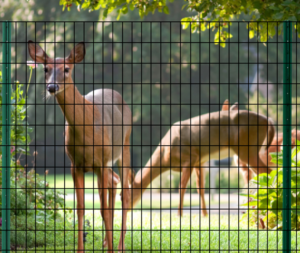Deer fencing is galvanized steel welded wire enhanced with a black plastic vinyl coating (PVC) for extra durability and weather resistance. Available in 14 and 20 gauges, Wire Cloth Man’s wire is strong, rust-resistant and long-lasting.
Deer fencing is ideal for a vegetable garden fence, boundary fencing and other lawn and garden enclosures. Protect your property against deer, small animals and rodents.

Deer fencing offers numerous advantages, providing an effective and durable solution for protecting your property:
Installing deer fencing is a straightforward process. Follow these steps to achieve success:
Plan and measure: Begin by determining the area that needs to be fenced. Measure the perimeter to calculate the amount of fencing material required. Consider any gates or access points and ensure they are included in your plan.
Gather materials and tools: Collect all necessary materials, including deer fencing, fence posts, post caps, ties or clips, a post driver, a measuring tape and a level. Ensure you have all the tools needed for the installation process.
Mark post locations: Use stakes and string to mark the locations where the fence posts will be installed. Space the posts evenly, typically 8 to 12 feet apart, ensuring stability and support for the fence.
Install corner and end posts: Start by installing the corner and end posts, which provide the main structural support for the fence. Use a post driver or dig holes to the required depth so that the posts are level and securely anchored.
Install intermediate posts: Install the intermediate posts along the marked lines, maintaining consistent spacing. Ensure each post is plumb (vertically level) and firmly set in the ground.
Attach the fencing material: Unroll the deer fencing and attach it to the posts, starting from one corner. Use ties, or clips to secure the fencing to the posts, ensuring it is taut and evenly distributed. Work your way around the perimeter, attaching the fencing to each post.
Secure the bottom of the fence: To prevent deer and other animals from slipping underneath, secure the bottom of the fence to the ground. Use stakes, landscape staples or bury the fence a few inches into the soil.
Install gates: If gates are part of your plan, install them at the designated access points. Ensure the gates are properly aligned and securely attached to the posts for easy opening and closing.
Inspect and adjust: Once the fence is installed, inspect the entire perimeter to ensure it is properly secured and free from gaps. Make any necessary adjustments to ensure the fence is taut and stable.
Maintain the fence: Regularly inspect the fence for any signs of damage or wear. Perform routine maintenance, such as tightening loose ties or repairing any breaks, to ensure the fence remains effective over time.
Wire Cloth Man offers high-quality deer fencing in various sizes. Our industry experts have over 100 years of cumulative experience, allowing us to provide you with durable deer fencing that keeps animals out.
We offer a range of custom-fabricated products tailored to your precise wire mesh requirements:
We deliver premium services and swift turnaround times with state-of-the-art machinery and a skilled workforce across our Cutting, Slitting, Stamping, Weaving, and Welding departments. Our experienced manufacturing team prioritizes quality to ensure you receive superior products at competitive prices.
Deer netting is a lightweight mesh material used to protect gardens, crops or landscaping from deer. It acts as a physical barrier to prevent deer from entering areas where they can cause damage by feeding on plants.
A deer fence should ideally be at least 8 feet high. Deer are capable jumpers and can easily clear lower fences. An 8-foot height is generally sufficient to deter most deer from attempting to jump over.
To keep deer out of a garden, ensure the fence is at least 8 feet tall and consider using additional deterrents like angled extensions, electric wires or double fencing. You can also use repellents, motion-activated sprinklers or noise devices to make the area less attractive to deer.
Netting can be effective in stopping deer, especially when used to cover individual plants or small garden areas. However, for larger areas, netting might need to be combined with other deterrent methods, as deer can sometimes push through or find ways around it if it is not properly secured.
You should also consider the size of the mesh openings relative to the intended use; smaller mesh sizes are better for keeping out smaller pests, while larger mesh sizes may be suitable for general fencing needs. Balancing the gauge and mesh size according to the project’s demands will ensure optimal performance and longevity.
Reach out now and get a quote from one of our dedicated sales members.